 by "ttyymmnn" (ttyymmnn)
by "ttyymmnn" (ttyymmnn)
Published 03/10/2017 at 12:35
 by "ttyymmnn" (ttyymmnn)
by "ttyymmnn" (ttyymmnn)
Published 03/10/2017 at 12:35
Tags: planelopnik history
; Planelopnik
STARS: 10
Welcome to This Date in Aviation History , getting you caught up on milestones, important historical events and people in aviation from March 8 through March 10.
!!! UNKNOWN CONTENT TYPE !!!
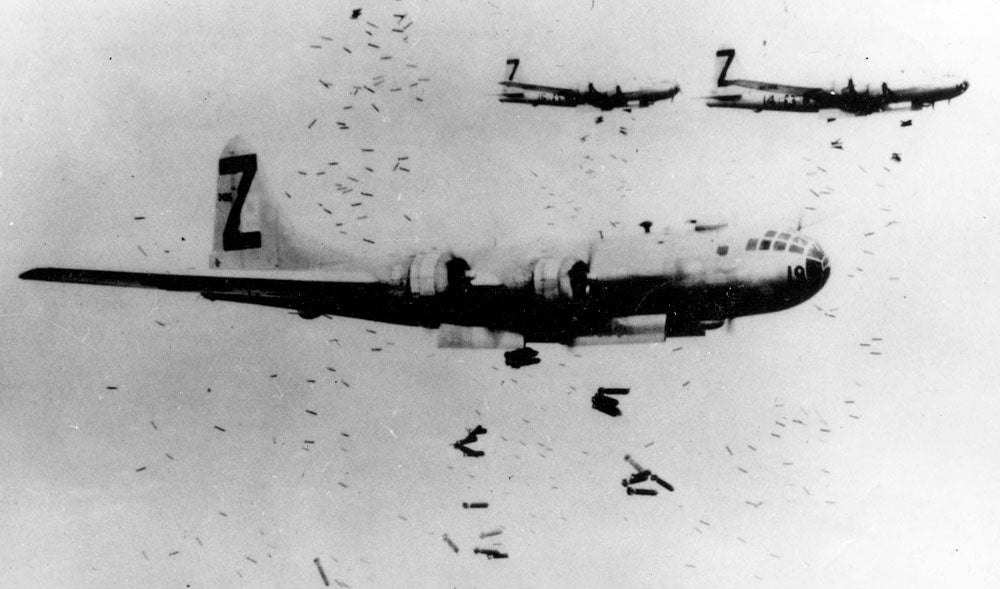
March 9-10, 1945 – The US Army Air Forces carries out Operation Meetinghouse, the first fire bombing raids on Japan. In the closing months of WWII, the campaign of island hopping brought the United States and its allies closer and closer to the Japanese home island. Flying from hastily built or captured airfields, American bombers steadily increased the number and magnitude of strategic bombing raids against Japan’s manufacturing assets in an effort to destroy Japan’s ability to equip her forces and to destroy the Japanese will to fight. Unlike European countries, where manufacturing was generally centered in large factories and industrial regions, Japan’s war materiel was mostly produced in small factories dotted around the country, and in homes as a cottage industry, where individual Japanese citizens manufactured munitions on a small scale. This dispersal of manufacturing assets rendered high altitude “precision” daylight bombing raids largely ineffective. In 1944, US Army Air Forces General Curtis LeMay , a veteran of Eighth Air Force strategic bombing attacks against Germany, transferred to the China-Burma-India theater and eventually took charge of all strategic bombing missions against Japan. A staunch advocate of strategic bombing, LeMay saw that American efforts were largely ineffectual because the islands of Japan were often covered in clouds, making accurate targeting more difficult if not impossible. Many of the bombs dropped from high altitude were blown off course by the jet stream, and deadly air defenses ruled out large scale low-level daylight raids. To increase the effectiveness of the bombing, LeMay advocated a switch to nighttime incendiary raids, where bombers flew at altitudes of 5,000-8,000 feet. With incendiaries, accuracy was not required, as fires started in the cities would do more damage than traditional high explosive bombs. In order to increase the carrying capacity of the bombers, all defensive armament was removed since, by 1945, Japanese aerial defenses against attack were sparse, and night attacks made antiaircraft artillery less effective. For the firebombing missions, Boeing B-29 Superfortresses were armed with M-69 incendiary bombs. A single M-69 munition weighed only 6 pounds, but they were dropped inside canisters that held 38 munitions each. Normally, each B-29 carried 37 canisters, totaling 1,400 individual incendiary munitions per plane. After the containers were dropped, they opened automatically, dispersing the smaller munitions which ignited on contact with the ground and spread a jellied gasoline compound that was highly flammable. The Japanese capital city of Tokyo was chosen as the target for the first raid, codenamed Operation Meetinghouse . On March 9, 1945, 346 B-29s left Guam and headed for the Japanese capital. Arriving over the city at 2:00 am on March 10 (Guam time), 279 bombers dropped almost 1,700 tons of incendiaries on a city built almost entirely of wood. The resulting fires destroyed 16 square miles of buildings, or 7% of the city’s urban area. The fires burned so fiercely that many died from suffocation as the raging firestorm consumed all the oxygen.

Following the raid, Tokyo police estimated that 83,793 people were killed, 41,000 injured and another 1 million left homeless. Postwar estimates place the toll as high as 100,000 killed. The USAAF lost 14 aircraft, less than the 5% loss rate that was considered acceptable. The firebombing raids continued in the belief that the attacks would lead the Japanese government to capitulate. They did not. According to one estimate , the firebombing campaign resulted in the destruction of 180 square miles in 67 cities, and killed more than 300,000 people, a number that far exceeds the combined death toll in both the Hiroshima and Nagasaki atomic bombings . At the time, the US had few moral qualms about destroying such large civilian population centers. Military planners earnestly believed that these raids would shorten the war and save American lives by preventing a costly invasion of the Japanese home island. Though it was hoped that the atomic bombings of August 6 and August 9, 1945 would finally compel the Japanese to surrender, no word was forthcoming from the Japanese government. Despite the horrors of the atomic bombs, two more firebombing raids were carried out before Japanese Emperor Hirohito finally announced Japan’s surrender on August 15, 1945, ending the Second World War. (US Air Force photos)
!!! UNKNOWN CONTENT TYPE !!!
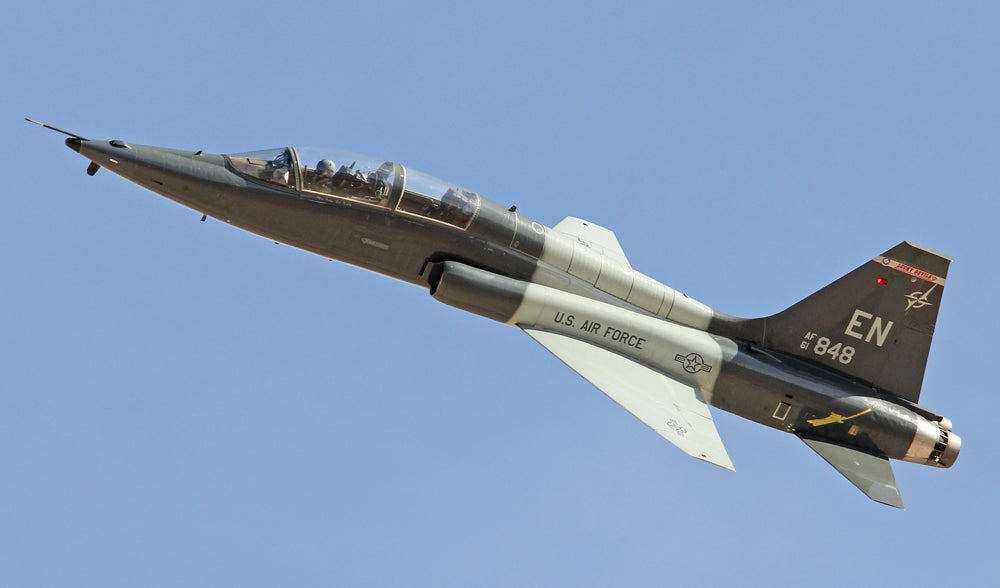
March 10, 1959 – The first flight of the Northrop T-38 Talon. Following the birth of the jet fighter in WWII, development progressed at a rapid pace. But as fighters became more sophisticated and more complex, they also became much bigger and heavier—and much more expensive. Northrop had started working on a light-class delta-winged fighter called the Fang , but the General Electric J79 engine alone would have weighed almost 4,000 pounds, and the program never progressed beyond preliminary drawings and a mock up. But in 1953, Northrop engineers learned of a new engine under development by General Electric that was intended for use in long-range missiles. The very small yet very powerful General Electric J85 weighed a mere 600 pounds, yet it produced about 3,000 pounds of thrust, giving it the highest thrust-to-weight ratio of any engine in its class. The Northrop team, lead by Edgar Schmued (the man who designed the North American P-51 Mustang ), saw an opportunity to buck the trend in fighter design and build a small, simple, yet extremely powerful fighter, with not one but two engines. Dubbed the N-156 by Northrop, the new fighter was initially developed for the US Navy, who planned to operate smaller fighters from the decks of escort carriers . But when the Navy began to phase out the escort carrier, they dropped the idea of a small fighter. Undaunted, Northrop continued with development of their new fighter, now called the N-156F, spending their own money to do so. (The N156F would eventually resurface as the F-5 Freedom Fighter, and win the International Fighter Aircraft competition in 1970.) By the mid-1950s, the Air Force began looking for a replacement for its aging fleet of Lockheed T-33 trainers. They wanted a two-seat, supersonic aircraft, and Northrop was waiting in the wings with the N-156T, which they had adapted from a fighter into a trainer. Thus, where most two-seat trainers come about as a development of a single-seat fighter, the trainer actually predated the fighter. Following the first flight of what was now called the YT-38 Talon, the Air Force quickly adopted the new trainer in 1961 and eventually purchased nearly 1,200 of them. The Talon went on to become the primary jet trainer for the US Air Force, and some estimates put the number of military pilots trained in the T-38 at more than 50,000.
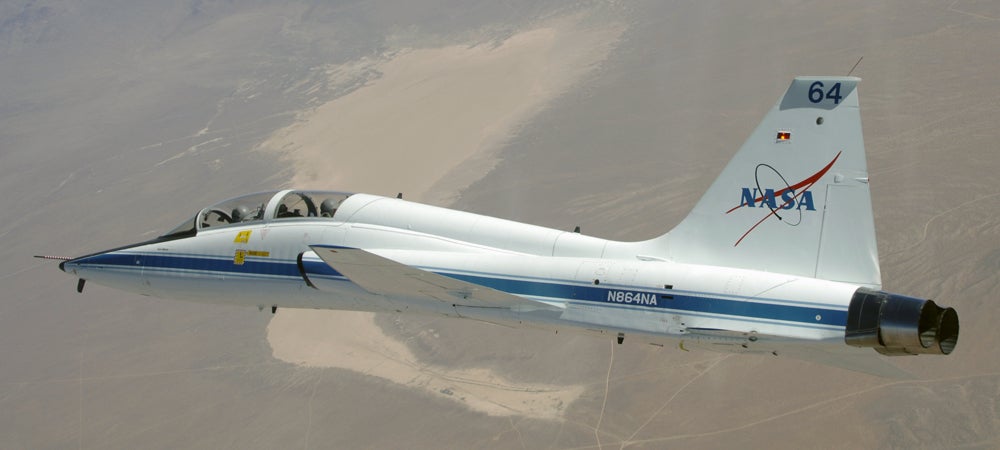
The Talon continues to be the workhorse of the US Air Force Air Education and Training Command (AETC), preparing pilots for the McDonnell Douglas F-15C Eagle and F-15E Strike Eagle , the General Dynamics F-16 Fighting Falcon , Boeing B-52 Stratofortress , Rockwell B-1B Lancer , Northrop Grumman B-2 Spirit , Fairchild Republic A-10 Thunderbolt II , Lockheed Martin F-22 Raptor and Lockheed Martin F-35 Lightning II . The T-38 was flown by the US Air Force Thunderbirds from 1974-1982 as a more fuel efficient and cheaper alternative to the McDonnell Douglas F-4 Phantom II during the OPEC oil embargo , and NASA also operates a fleet 32 Talons for astronaut flight training and for use as a chase plane. The Talon has now been in service for over 50 years, and the Air Force is currently fielding proposals for a replacement as part of the T-X program . With initial operational capability for the T-X slated for 2024, the Talon will be flying for a while longer. However, it remains to be seen if any new trainer will be able to match the capability and affordability of the venerable Talon. (US Air Force photo)
!!! UNKNOWN CONTENT TYPE !!!
!!! UNKNOWN CONTENT TYPE !!!
!!! UNKNOWN CONTENT TYPE !!!
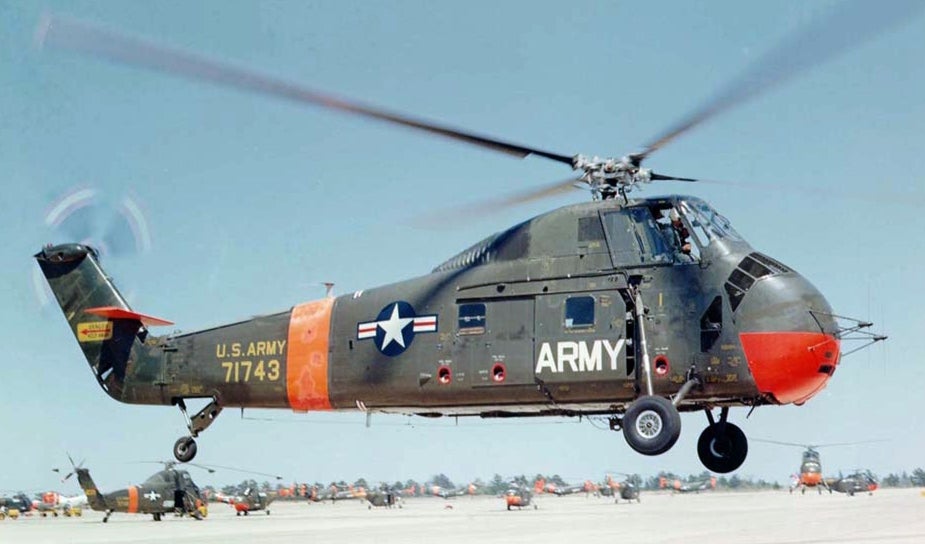
March 8, 1954 – The first flight of the Sikorsky H-34. A development of the H-19 Chickasaw , the H-34 was originally designed by Igor Sikorsky as an anti-submarine (ASW) platform for the US Navy. Powered by a Wright R-1820 radial engine in the nose that drove the main rotor by a drive shaft that passed up through the cockpit, the H-34 had a maximum speed of 173 mph and could carry up to 18 troops or 8 stretchers. The Army chose not to fly the H-34 in Vietnam, but the Marine Corps converted theirs into the first helicopter gunships by adding machine guns and rocket pods. The H-34 served the US until the mid-1960s, but also flew for numerous export countries around the world, as well as in a civilian version called the S-58. A total of 2,108 H-34/S-58s were built. (US Army photo)
!!! UNKNOWN CONTENT TYPE !!!

March 8, 1917 – The death of Count Ferdinand von Zeppelin. Count Zeppelin was born on July 8, 1838 in modern-day Baden Würtemberg and served as a general in the army of Würtemberg before turning his interest to aviation. During the American Civil War, Zeppelin traveled to the United States and observed the use of observation balloons in battle, then returned to Europe to develop first dirigibles and rigid airships. His first airship, LZ 1 , took its maiden flight in July 1900, and he followed it with ever larger airships that would eventually be capable of transatlantic flight. Zeppelins were used in combat during WWI, but their heyday ended in 1937 with the crash of the Hindenburg (LZ 129) and the advent of transatlantic airliners. (Photo via Deutsches Bundesarchiv)
!!! UNKNOWN CONTENT TYPE !!!
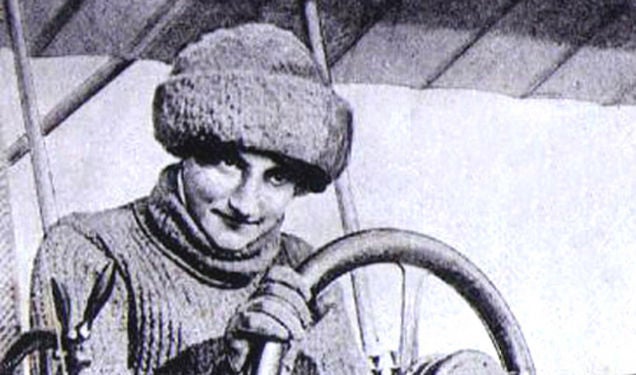
March 8, 1910 – Raymonde de Laroche becomes the world’s first woman to earn a pilot license. Born in 1882, de Laroche decided to become a pilot after seeing Wilbur Wright’s flying demonstration in 1908, and the next year she convinced her friend and airplane manufacturer Charles Voisin to teach her to fly. Since Voisin’s aircraft had only one seat, her first flight was a solo, and she covered some 300 yards. One year later, de Laroche received license #36 from the Fédération Aéronautique Internationale . She made numerous flying demonstrations around Europe and Egypt, and despite serious injuries she sustained in a crash, she returned to the air and was awarded the Aero-Club of France’s Femina Cup for a 4-hour nonstop flight. She also set two altitude records for women pilots in 1919. De Laroche died on July 18, 1919 in a crash that also killed her co-pilot. (Library of Congress photo)
!!! UNKNOWN CONTENT TYPE !!!

March 8, 1909 – The birth of Beatrice “Tilly” Shilling,
a British aeronautical engineer, motorcycle racer, and auto racer. Shilling is best known for her invention of the
R.A.E. Restrictor
, known to pilots as “Miss Shilling’s Orifice,” which helped eliminate the problem of engine flooding in the early
Rolls-Royce Merlin
engines used on the
Hawker Hurricane
and
Supermarine Spitfire
. Following the war, Shilling worked on the
Blue Streak
missile and investigated the effects wet runways on aircraft braking. As a racer, she was awarded the Gold Star for lapping the
Brooklands
circuit at an average of 106 mph on her
Norton
M30 motorcycle, and refused to marry her fiancé until he matched the feat and to a Gold Star of his own. Shilling died on November 18, 1990 at age 81.
(Photo author unknown)
!!! UNKNOWN CONTENT TYPE !!!
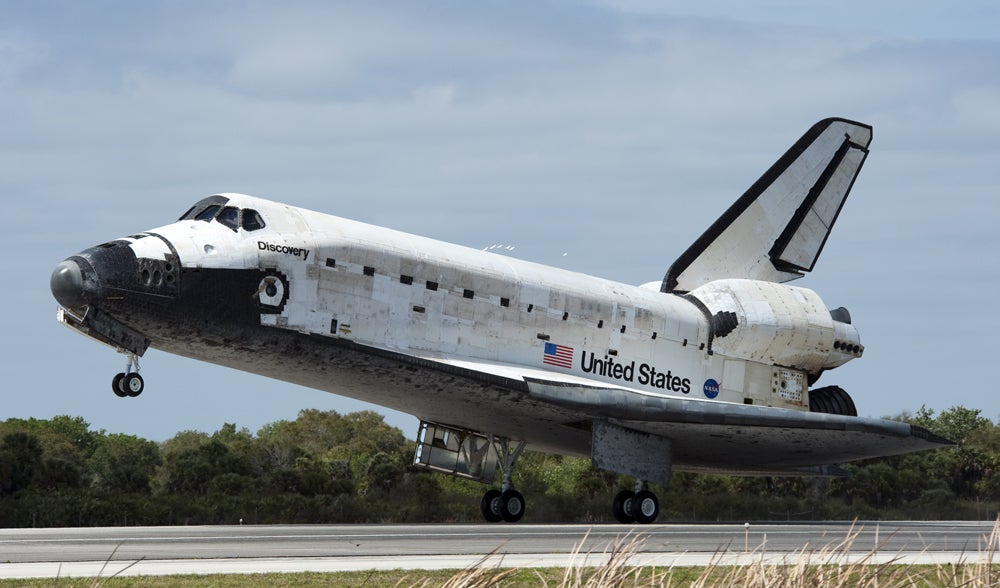
March 9, 2011 – Space Shuttle Discovery returns to Earth, marking the final mission of the first Space Shuttle to be retired by NASA. Discovery launched into space from the Kennedy Space Center for the last time on February 24, 2011, carrying a crew of 6 veteran astronauts and delivering the Permanent Multipurpose Module Leonardo , plus the humanoid robot Robonaut , to the International Space Station (ISS). The flight was the last of 39 missions spanning 27 years of service, more spaceflights than any other spacecraft to date. Discovery was the third orbiter to enter service after Columbia and Challenger , and made its maiden flight on August 20, 1984. All told, Discovery amassed more than a year in space. (NASA photo)
!!! UNKNOWN CONTENT TYPE !!!
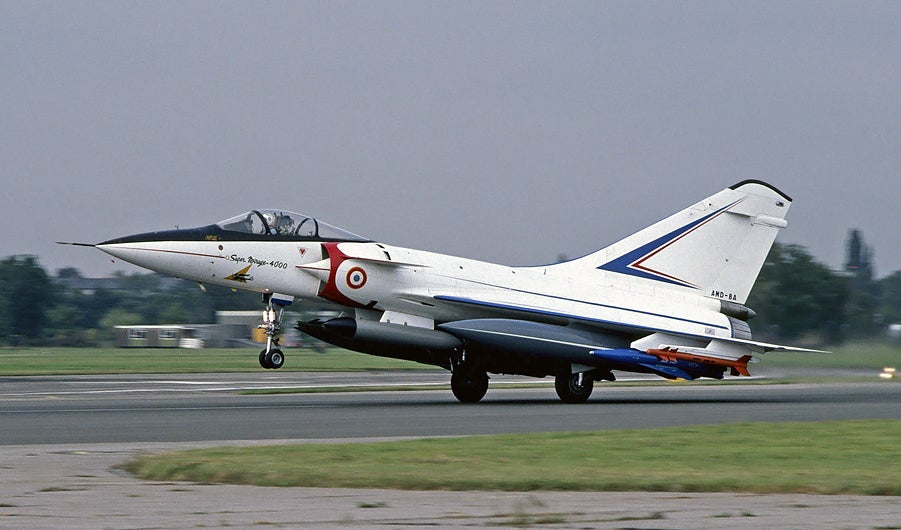
March 9, 1979 – The first flight of the Dassault Super Mirage 4000,
a significantly larger and heavier development of the single-engine
Mirage 2000
. Unlike the 2000, the 4000 had two
SNECMA M53-2
turbofan engines, as well as
canards
fitted above the air intakes. The Super Mirage was begun as a private venture by Dassault and developed to compete with the
McDonnell Douglas F-15 Eagle
for lucrative export contracts. When Saudi Arabia chose to purchase the F-15, the Super Mirage project was canceled, but Dassault used much of the data gleaned from the 4000 program in the development of the
Dassault Rafale
. Only one Mirage 4000 was built, and it now resides at the
Musée de l’Air et de l’Espace
in Paris.
(Photo by Steve Fitzgerald via
Wikimedia Commons
)
!!! UNKNOWN CONTENT TYPE !!!
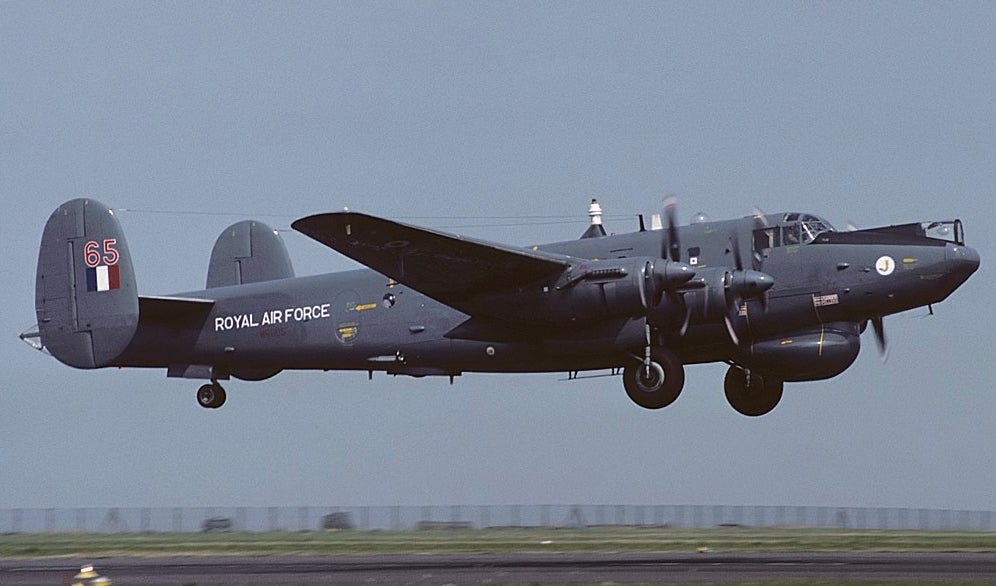
March 9, 1949 – The first flight of the Avro Shackleton. The Shackleton was a long-range four-engine maritime patrol aircraft that traces its lineage back to the Avro Lincoln bomber, which itself was a development of the Avro Lancaster bomber of WWII. Following its introduction in 1951, the Shackleton served the Royal Air Force and South African Air Force, seeing action with the RAF during the Suez Crisis in 1956. In addition to its maritime surveillance role, the Shackleton also served as a search and rescue platform, with one aircraft crew remaining on alert at all times should it be needed to respond to an emergency situation. A total of 185 Shackletons were built between 1951-1958, and it was retired from service in 1991. (Photo by Mike Freer via Wikimedia Commons )
!!! UNKNOWN CONTENT TYPE !!!
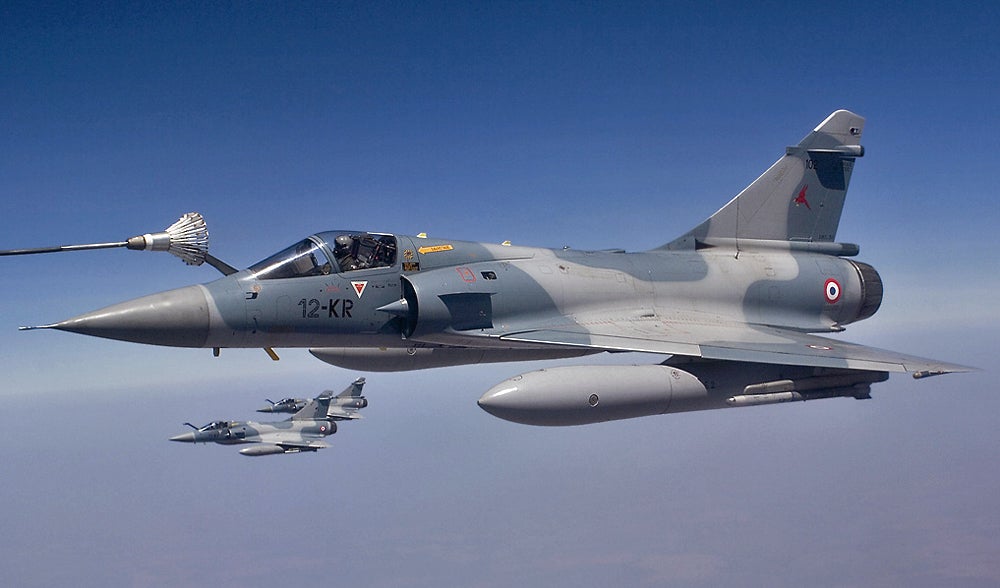
March 10, 1978 – The first flight of the Dassault Mirage 2000. Based on the delta wing Mirage III , the Mirage 2000 was developed in the 1970s as a lightweight fighter to compete with the General Dynamics F-16 Fighting Falcon for the export market. Since the Mirage 2000 was based on an existing successful aircraft, the prototype was ready for its first flight in just 27 months.. The Mirage 2000 entered service in November of 1982, and just over 600 examples were produced, with many sold to Dassault’s export customers. It saw service with the French during the Gulf War and in Afghanistan, and it remains in service today, though it is currently being phased out in favor of the Dassault Rafale . (Photo by Guilherme Bystronski via Wikimedia Commons )
!!! UNKNOWN CONTENT TYPE !!!
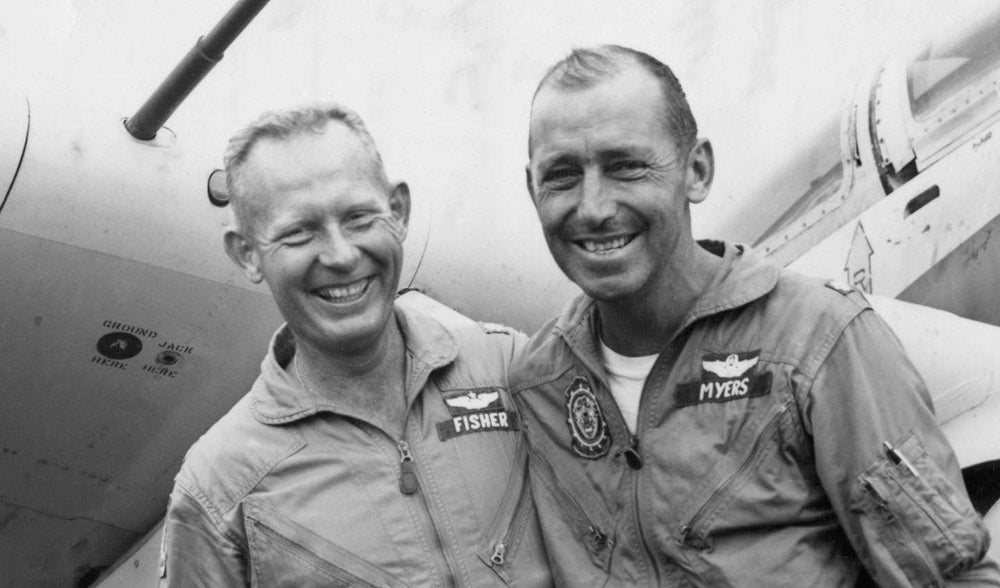
March 10, 1966 – US Air Force Maj. Bernard “Bernie” Fisher earns the Congressional Medal of Honor. Fisher was leading a two-ship team of Douglas A-1 Skyradiers as part of six aircraft supporting US troops in the A Shau Valley in Vietnam. One of the Skyraiders, piloted by Maj. D.W. “Jump” Myers was hit and forced to land on an airstrip belonging to CIDG and US Special Forces. With the closest rescue helicopter at least 3o minutes away, Fisher decided to land his Skyraider under heavy enemy fire and pick up the downed pilot. Dodging craters and debris on the runway, Fisher took off, his Skyraider riddled with holes from small arms fire. For his actions, Maj. Fisher was awarded the Medal of Honor , becoming the first member of the US Air Force to receive the award in the Vietnam War. (US Air Force photo)
!!! UNKNOWN CONTENT TYPE !!!
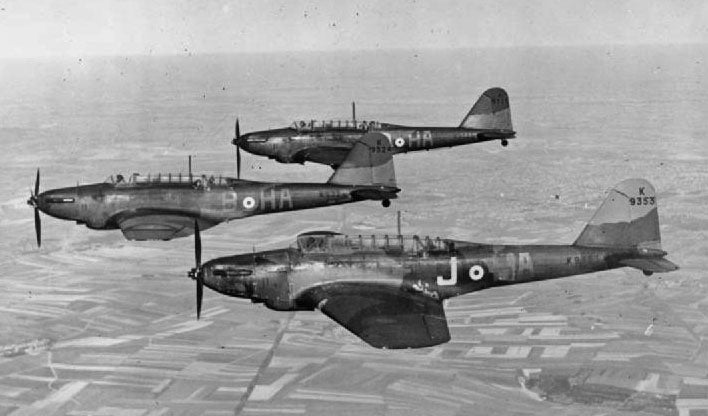
March 10, 1936 – The first flight of the Fairey Battle.
The Battle was originally conceived as a replacement for older biplane bombers, and though it was powered by the same
Rolls-Royce Merlin
V-12 engine used in some of the most successful aircraft of WWII, it was severely hampered by its size and weight. While it was a significant improvement over the biplanes it replaced, it was completely obsolete by the outbreak of WWII. In addition to its lack of speed and average handling, it also lacked an armored cockpit and self-sealing fuel tanks, making it vulnerable to antiaircraft fire and enemy fighters. Nevertheless, Battles saw extensive, if somewhat futile, service in the early days of the war, but were withdrawn from frontline service by the end of 1941.
(UK Government photo)
!!! UNKNOWN CONTENT TYPE !!!
!!! UNKNOWN CONTENT TYPE !!!
!!! UNKNOWN CONTENT TYPE !!!
!!! UNKNOWN CONTENT TYPE !!!
!!! UNKNOWN CONTENT TYPE !!!
!!! UNKNOWN CONTENT TYPE !!!
!!! UNKNOWN CONTENT TYPE !!!
If you enjoy these Aviation History posts, please let me know in the comments. And if you missed any of the past articles, you can find them all at Planelopnik History . You can also find more stories about aviation and aviators at Wingspan and Planes You’ve (Probably) Never Heard Of .
!!! UNKNOWN CONTENT TYPE !!!
 "RamblinRover Luxury-Yacht" (ramblininexile)
"RamblinRover Luxury-Yacht" (ramblininexile)
03/10/2017 at 12:45, STARS: 2
Tilly! She’s an inspiration to anyone who would like to remember to think of simple solutions in engineering. Sometimes, it doesn’t
have
to be a hard fix.
 "Ash78, voting early and often" (ash78)
"Ash78, voting early and often" (ash78)
03/10/2017 at 12:48, STARS: 1
If anyone ever doubts the need for the atomic bomb at the time, just read that firebombing story a couple times. Definitely a lesser of two evils thing. I would never have wanted to be in that situation to make a decision. Both of my grandfathers served in close combat in the Pacific islands and the no-surrender attitude was pervasive. No Western warfare had ever seen anything like it before and we were totally unprepared.
 "For Sweden" (rallybeetle)
"For Sweden" (rallybeetle)
03/10/2017 at 12:49, STARS: 2
TWO Mirages?
strikes up La Marseillaise
 "For Sweden" (rallybeetle)
"For Sweden" (rallybeetle)
03/10/2017 at 12:50, STARS: 1
Anyone who doubts the bombing raids over Japan should tell what the acceptable tactics are for fighting fascism.
 "MonkeePuzzle" (monkeypuzzle)
"MonkeePuzzle" (monkeypuzzle)
03/10/2017 at 12:52, STARS: 3
but the General Electric J79 engine alone would have weighed almost 4,000 pounds, and the program never progressed beyond preliminary drawings and a mock up. But in 1953, Northrop engineers learned of a new engine under development by General Electric that was intended for use in long-range missiles. The very small yet very powerful General Electric J85 weighed a mere 600 pounds, yet it produced about 3,000 pounds of thrust
that is an ASTOUNDING drop in weight! just astonishing engineering.
 "HammerheadFistpunch" (hammerheadfistpunch)
"HammerheadFistpunch" (hammerheadfistpunch)
03/10/2017 at 12:56, STARS: 1
I’ve been geeking out on F5/F20 videos lately, what an amazing plane. Also I LOVE the H34/S58.
 "For Sweden" (rallybeetle)
"For Sweden" (rallybeetle)
03/10/2017 at 12:57, STARS: 1
I hope you fly Sabena then
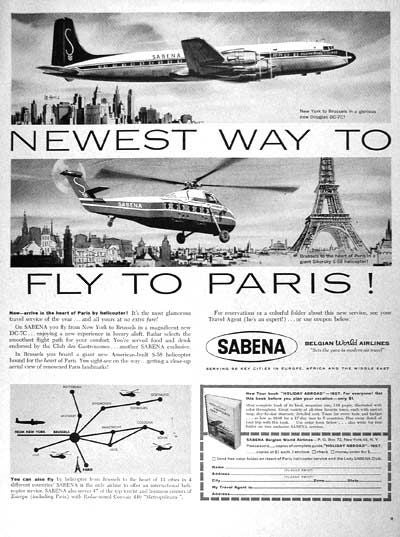
 "HammerheadFistpunch" (hammerheadfistpunch)
"HammerheadFistpunch" (hammerheadfistpunch)
03/10/2017 at 12:59, STARS: 0
Le Sigh
 "ttyymmnn" (ttyymmnn)
"ttyymmnn" (ttyymmnn)
03/10/2017 at 13:02, STARS: 2
I had to check those numbers at a couple of different sources. I finally found a USAF maintenance site with the 600 lb number. I’m still incredulous, and waiting for someone to correct me. The link in the text goes to the AF site, not Wiki.
 "ttyymmnn" (ttyymmnn)
"ttyymmnn" (ttyymmnn)
03/10/2017 at 13:03, STARS: 6
You only THINK you see two.
 "For Sweden" (rallybeetle)
"For Sweden" (rallybeetle)
03/10/2017 at 13:05, STARS: 1
o_o
 "ttyymmnn" (ttyymmnn)
"ttyymmnn" (ttyymmnn)
03/10/2017 at 13:06, STARS: 1
The US had wanted to drop the bomb on Berlin, but it wasn’t ready yet. They also feared the Germans getting the tech if the bomb failed to detonate. Still, I have to believe that it was easier for the US to drop it on “those yellow bastards” than on Europe, with our shared heritage. I’ve found nothing to support that supposition, though.
 "Leon711" (leon711)
"Leon711" (leon711)
03/10/2017 at 13:10, STARS: 1
When I was a teen I used to be in the Army Cadets and we used to use the Crowborough training camp in East Sussex for numerous things. Anyway, when we had to do PT we ran around the perimeter of the camp, we used to stop at a parade ground to stretch out and at the back there was a derelict Westland Whirlwind, the British built version of the Sikorsky, I loved that thing.
 "My bird IS the word" (mybirdistheword)
"My bird IS the word" (mybirdistheword)
03/10/2017 at 13:13, STARS: 1
Well it always gets me how people complain about the atomic bombs and completely forget the firebombing. I would say the nukes are a tad bit more humane.
Also civilians were valid military targets on every front in every theater.
 "ttyymmnn" (ttyymmnn)
"ttyymmnn" (ttyymmnn)
03/10/2017 at 13:15, STARS: 0
Westland also made a version of the Whirlwind with a turbine engine to replace the Cyclone radial. It’s recognizable by the two intakes in the nose.
 "Smallbear wants a modern Syclone, local Maple Leafs spammer" (smallbear94)
"Smallbear wants a modern Syclone, local Maple Leafs spammer" (smallbear94)
03/10/2017 at 13:15, STARS: 2
Military planners earnestly believed that these raids would shorten the war and save American lives by preventing a costly invasion of the Japanese home island.
Not just American lives (though at that point that’s all that they would’ve been concerned about).
Had the invasion gone ahead, all Japanese men and women who weren’t already in the military (within age brackets, can’t recall exactly—want to say 15-65 for men and 18-45 for women? dunno) were ordered to meet the invaders on the beaches with sharpened bamboo poles. Given the Japanese philosophy of death being better than surrender that would have the casualties in multiple millions of people.
Also is it a bad sign that I saw that picture and immediately thought “Miss Shilling’s Orifice”...
 "ttyymmnn" (ttyymmnn)
"ttyymmnn" (ttyymmnn)
03/10/2017 at 13:17, STARS: 2
Operation Downfall would have been a bloodbath on both sides. It’s best for all parties that it was never carried out.
Also, Tilly Shilling is simply a badass.
 "Ash78, voting early and often" (ash78)
"Ash78, voting early and often" (ash78)
03/10/2017 at 15:20, STARS: 1
I’ve heard the same and don’t doubt it in the least — the eastern seaboard of the US which was still, at the time, the braintrust and wealth center of country, were almost all just a generation or two removed from Europe. It’s far easier to make enemies with someone who looks and acts almost nothing like you. Sick, but true. I honestly believe that the anti-Japanese brainwashing made our soldiers more aggressive, while the Japanese anti-American brainwashing (of both their soldiers and the local occupied populations, such as the Philippines) was even more nefarious. But same idea.
 "ttyymmnn" (ttyymmnn)
"ttyymmnn" (ttyymmnn)
03/10/2017 at 16:39, STARS: 1
A quick search of American propaganda posters shows no shortage of images like these, but there are very few (that I could find) showing Germans in a similar light. Mostly just drawings of a buffoonish Hitler.
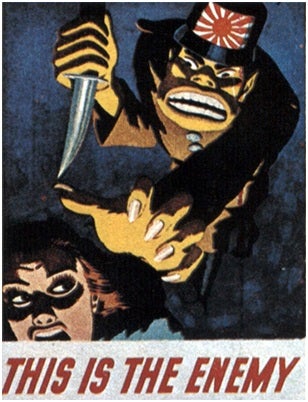
 "pip bip - choose Corrour" (hhgttg69)
"pip bip - choose Corrour" (hhgttg69)
03/10/2017 at 22:16, STARS: 0
no MH370 mention?
 "ttyymmnn" (ttyymmnn)
"ttyymmnn" (ttyymmnn)
03/10/2017 at 22:56, STARS: 0
Did I miss it?
 "pip bip - choose Corrour" (hhgttg69)
"pip bip - choose Corrour" (hhgttg69)
03/10/2017 at 23:00, STARS: 0
Wed just gone March 8.
 "ttyymmnn" (ttyymmnn)
"ttyymmnn" (ttyymmnn)
03/10/2017 at 23:32, STARS: 0
Dang. My source for dates doesn’t stay very up to date.
 "Rusty Vandura - www.tinyurl.com/keepoppo" (rustyvandura)
"Rusty Vandura - www.tinyurl.com/keepoppo" (rustyvandura)
03/13/2017 at 12:00, STARS: 1
That’s because they’re now looking to you. It’s a circular reference, probably not unlike Miss Shilling’s Orifice.
Nice column. Just couldn’t give it up?
 "Rusty Vandura - www.tinyurl.com/keepoppo" (rustyvandura)
"Rusty Vandura - www.tinyurl.com/keepoppo" (rustyvandura)
03/13/2017 at 12:07, STARS: 1
The book
The English Patient
ends with the dropping of the atomic bomb(s) on Japan. One of the two main characters, Kip, an Indian, says that the Allies never would have dropped the Bomb on a White nation. Great novel. A bit plodding, but very lyrical and sensual. And from what I’ve seen of the trailers, very
unlike
the movie. For one thing, in the novel, the two main characters were only 18 or 19 years old.
 "ttyymmnn" (ttyymmnn)
"ttyymmnn" (ttyymmnn)
03/13/2017 at 12:39, STARS: 0
I stopped so I could focus on my audition. Now that it’s over, I thought I’d get back to it.
 "ttyymmnn" (ttyymmnn)
"ttyymmnn" (ttyymmnn)
03/13/2017 at 12:42, STARS: 0
Never saw the film or read the book, but it’s more support for my opinion.
 "Rusty Vandura - www.tinyurl.com/keepoppo" (rustyvandura)
"Rusty Vandura - www.tinyurl.com/keepoppo" (rustyvandura)
03/13/2017 at 12:49, STARS: 0
Indeed, though it’s also a blatant example of art as overt social commentary. I entirely agree with Michael Ondaatje’s sentiment, but a spade is a spade.
 "ttyymmnn" (ttyymmnn)
"ttyymmnn" (ttyymmnn)
03/13/2017 at 12:54, STARS: 0
Is there a problem with art as social commentary? During the German occupation of Paris, Pablo Picasso handed out photographs of his Guernica painting to German soldiers. When they asked, “Did you do this?” he replied, “No, you did.”

 "Rusty Vandura - www.tinyurl.com/keepoppo" (rustyvandura)
"Rusty Vandura - www.tinyurl.com/keepoppo" (rustyvandura)
03/13/2017 at 13:02, STARS: 0
No, definitely not, though your question causes me to pause and ponder my earlier comment. I think there lies a difference in the forms of the art, and peoples’ reactions to them. Where
Guernica
hangs on the wall and
anyone
may gaze upon it and react how they might,
The English Patient
will only engage the determined reader with its closing pages. And there was some heavy sledding in parts. As a result, I think that folks commenting on
The English Patient
will tend to be a more particular group of people, likely lettered people, and my comment about the social commentary in Ondaatje’s writing would be addressed more to them. To a bunch of Liberals. I would argue that because of its accessibility, cubism aside,
Guernica
is much the more accessible commentary.